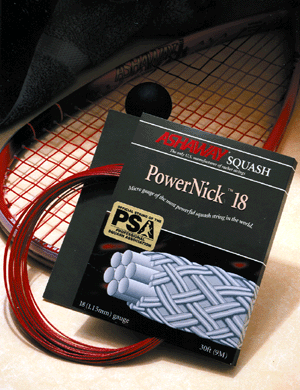|
|

From Form and Finesse to Fast and Furious II
By Steve Crandall
Vice President, Sales & Marketing
Ashaway Racket Strings

A thinner string, like Ashaway's PowerNick® 18, bites into the ball for better spins and slices. This Zyex string holds tension well, and when strung tightly, provides optimum ball control. |
In our last column we talked about the "personality" of different racket sports, in particular, how squash relies on form, finesse and fitness, while racquetball thrives on fast, "furious" and fitness. Now let's look at how these distinctions affect stringing choices.
Stringing For Form Vs. Fast
We said in the previous column that form is essential to good squash playing, specifically because the squash ball is soft and slow. This requires players to move to the ball, rather than wait for the ball to come to them. Good form allows better control of shots, keeping your opponent on his or her toes.
A more tightly strung racket can also increase control. With a stiff string bed, the ball bounces off the racket face at a single instant. The player can anticipate the moment of impact, and adjust the racket angle to optimize control over the placement of the shot.
In racquetball, speed is the name of the game, with typical drive serves clocked at 100 to 130 mph. It makes sense, then, that racquetball players want to increase power. Looser tensions will achieve this, based on the trampoline effect - or the rapid stretch and rebound of the string bed as it contacts the ball. The more resilient the string bed, the more power it generates.
Stringing For Finesse Vs. Furious
Squash is a cat-and-mouse game where hitting drop shots up front, solid "rails" along the wall, and well-placed lobs in the back corners gives you the competitive edge. Squash requires finesse. Again, the name of the game is control. Thin strings penetrate the surface of the squash ball a bit deeper on impact, giving players better command over ball placement. Textured string surfaces also enhance spins and slices for optimum ball control.
Conversely, racquetball rallies are based on power, with the best shot being the "kill shot," which is hit fast and low to the ground. The game is furious. Thicker strings provide maximum durability, and reduce the chance of a string breaking midpoint--and interrupting momentum.
Stringing For Success
Does this mean that a squash player has to sacrifice power to gain control? Or that racquetball players can't pinpoint where their shots land?
Absolutely not. New, modern materials and string manufacturing techniques offer racket sport players a wide range of playing characteristics, all in a single string.
Zyex(r) fiber squash strings, for instance, offer superior tension-holding properties--ideal for players who string tightly--and they add tremendous power. At gauges as thin as 18, or just 1.15 mm, they really bite into the ball, for added control.
Nylon multifilament strings have also come a long way. Textured surfaces enhance spins and slices, while the multifilament construction offers gut-like performance and playability. Lighter gages provide a combination of ball control and optimum resiliency.
For racquetball strings, Zyex fibers increase power and playability at the same time, and offer better feel. Some nylon polymer strings now have an abrasion resistant wear layer that defends against notching--a notorious string killer in the fast and furious game of racquetball.
"Hybrid stringing," or using two distinctly different types of string - one for the mains and another for the crosses, is very popular in racquetball. It lets players take advantage of the best properties each of the strings has to offer. For example, a racket strung with 16-gauge Aramid mains and nylon polymer crosses provides a firm string bed, good bite on the ball and exceptional durability. Dropping the gauge of either or both strings to 17 will increase playability. Players can achieve these traits with prepackaged hybrid strings, or by customizing their own combination--some even substituting squash string for maximum resiliency and feel.
Squash and racquetball players will have more and more choices as string materials and manufacturing techniques continue to advance. The key to choosing the right string for your game is to know your sports personality, and then pick a string that maximizes your performance.
This article previously appeared in Squash Magazine.
ZYEX® is a registered trademark of Victrex Ltd.
|